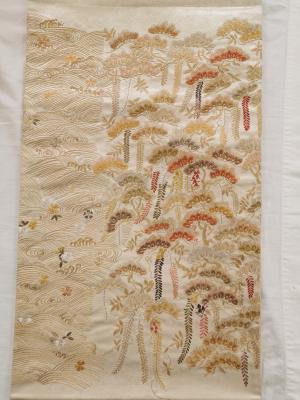WHITEWORK, SHAWL
Exquisitely worked whitework muslin triangular shawl was called a kerchief or fichu in late 17th and early 18th Century, similar to Scottish Ayrshire whitework and to Indian chikanari. An expensive luxury which would has been preserved carefully.
The fichu, kerchief, neckerchief or shawl, a large square of flimsy fabric folded into a triangle, or cut as a triangle, was worn draped over the shoulders or around the neck, with the ends drawn together and secured with a brooch or tied around the waist at front or at back.
In the 18thC Western fashions, necklines of bodices were cut revealingly low either square or a wide, off the shoulder oval . Some bodices closed centre front with a hook, laces or pins and so a fichu was worn to conceal the closure or for reasons of modest.
At apex, 730mm each side and 630mm up, is beautiful whitework delicate embroidery. Centre are two grapes leaves and under this and on the sides, chrysanthemum flowers centres with pulled fabric embroidery. Around this, extending along the sides of the fichu for 730 mm are sprays of daisies and sprays of assorted leaves. Along the sides of the fichu is a pulled fabric band, 20 mm deep. The long side has a raw edge, having been cut.
Details
Details
Embroiderers' Guild of WA Textile Museum
Embroiderers' Guild of WA Textile Museum
Other items from Embroiderers' Guild of WA Textile Museum
Scan this QR code to open this page on your phone ->


